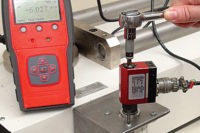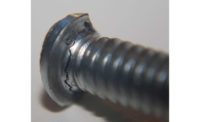
Technology can often be a “guiding hand” to assemblers. The correct technological assistance can dramatically reduce operator training time, simplify the assembly process and enhance error-proofing. When it meets these three goals, guided assembly can be a win-win-win situation for the assembler, manufacturer and end-user.
Products designed to guide manual assembly have been around for several years. The most popular product categories are pick-to-light systems and tool support arms.

When hand motion breaks the infrared
beams across each Smart Bin opening, sensors determine whether or not the
correct part has been selected. Graphic courtesy SpeasTech Inc.
Lighting the Way
Among the various pick-to-light products on the market is the recently redesigned Smart Bin by SpeasTech Inc. Smart Bin helps the assembler choose the correct part at the right time within a programmed sequence. It features a modular design that allows easy stacking and reconfiguring. The bin comes in different sizes, including one that accommodates the industry-standard 5 inches wide, 5-1/2 inches high and 10-7/8 inches deep.A specific part sequence is programmed into the bin while in the “learn” mode. By switching the bin to “run” mode, the assembler activates the sequence. Lights above each bin direct the assembler to the correct part choice and sequence. When hand motion breaks the infrared beams across each bin opening, sensors determine whether or not the correct part has been selected. Selecting the wrong part causes an alarm to sound.
“Our sensor detects the whole hand, and this guarantees a one-pick operation,” says Gary Speas, president of SpeasTech.
Banner Engineering Corp.’s pick-to-light system features a parts verification array and translucent dome-shaped bin sensors that can be different colors. The verification array, which has an emitter and a receiver, is mounted so that its light beams stretch across each bin. The array interfaces to a system controller that is preprogrammed for a specific sequence of tasks.
When a bin sensor lights up, the assembler reaches into that bin, and the array senses if the correct part has been taken. If it has, the next bin in the sequence is lighted. If it hasn’t, the first bin sensor stays lit. The array, which has an operating range up to 2 meters, also can be wired to signal an alarm in the event an incorrect part is selected.
The Light Guide System, from OPS Solutions LLC, consists of software and an overhead high-lumen projector. Individual part selection and assembly steps are programmed in the software, using drop-down menu selections.
Preprogrammed visual display features (VDFs)-which may contain instructional text, numbers, workstation location coordinates, colors, graphics, videos and animation-are projected directly onto a work surface or on parts bins where they can easily be seen. The VDFs automatically guide the operator through each step of the part selection and assembly process.
Manual or automatic confirmation that a step has been performed is required before the next step is activated. This setup not only verifies that all steps were completed in the correct order. It also provides a standardized process across all operators and shifts, including standardizing bolt torque sequences.
Cycle times for each step are displayed on the workstation interface screen, and all cycle time and part number data are stored. This data allows managers to perform bottleneck analysis, production trending and cycle time reporting.
Another system advantage, according to OPS Solutions President Paul Ryzner, is it requires no wiring of bins and places no restrictions on their location. He says a large auto supplier is using the system for assembly of a charge coupler used in electric vehicles. Also, a large automaker is using the system with accompanying audio instructions for kitting.

Each module in the Build to Light system features an LED display that
can indicate the step number in the assembly process or the number of parts to
be removed from a bin. Graphic courtesy Lightning Pick Technologies.
Each module features an LED display and a “confirm” indicator. The LED display can be used to indicate the step number in the assembly process or the number of parts to be removed from a bin. Modules are mounted to racks and linked to the connector by an AW or TW cable. The controller can control up to 150 modules.
The assembler scans the bar code of a part, and the lighting sequence begins. Some modules require the assembler to press the confirm indicator after each completed step. Other modules offer hands-free confirmation. If preferred, the assembler can follow the step-by-step assembly process on an accompanying monitor, which the manufacturer must provide and mount on the rack.
“The system is not a complete substitution for full inspection,” says Jim Bast, general manager of Lightning Pick Technologies. “But it is designed to raise the accuracy level of all workers.”
Instead of using light signals to guide assemblers, manufacturers may want to provide audible commands. Patlite offers a voice annunciator that plays audible assembly instructions recorded as MP3 files. The annunciator is integrated with a PLC that triggers the playing of the instructions or audible sounds.
According to Paul Mizuki, marketing manager for Patlite, the annunciator can play 2 hours of instructions or up to 127 assembly steps. The MP3 files are stored on an SD card, enabling manufacturers to easily change instructions. Mizuki says an automaker in Japan uses the device to help workers assemble and test wire harnesses.

Encoders installed in the joints of the Smart-Arm help the assembler
place a power tool at the correct location before installing a fastener and
install fasteners in the right sequence. Graphic courtesy Kolver USA.
A Helping Arm
Swing arms, or tool support arms, are well-liked by assemblers who perform fastening with power tools because they lessen operator fatigue. The standard arm features two main pivot posts that enable the tool to move freely along the X and Y axes.However, these arms can also be used for guided assembly. Encoders installed in the joints of the arm can be tracked by a nearby control box to help the operator select the correct tool, place it at the correct location before installing a fastener, and install fasteners on a product in the right sequence.
Kolver USA’s Smart-Arm system not only provides these benefits, it can program pre-torque and final torque requirements up to a rating of 300 newton-meters. The system features three encoders to ensure proper tool positioning along the X, Y and Z axes. For simplicity, the system does not need to be connected to a PLC.
“The system also can be integrated with bins used in pick-to-light systems to ensure proper selection of screw bits or fasteners,” says Jim Chase, president of Kolver. “If the assembler selects the wrong part, the tool will not work.”
Kolver offers midsized swing arms, whereas GCI offers very large swing arms that feature five encoders and have a torque rating up 4,000 newton-meters. At the other end of the spectrum, Assembly Automation offers smaller units with just two encoders and torque rating up to 30 newton-meters.

The Position Control Stand is tethered to
a PLC-based controller, which features an LED screen that displays each action
of the assembly process. Photo courtesy DEPRAG Inc.
After it’s turned on, the PKS can start from any position, rather than having to be moved over a reference point. Multiple inputs and outputs enable the controller to direct each location of the tool during the assembly process, as its TouchPanel screen displays the required action. Fastening data is stored on-board or transmitted to a shop-floor network by a TCP-IP module.
For increased flexibility, individual working positions can be set or changed without needing to correct other positions of the work sequence. Also, the stand can be integrated with a screw feeder, and it can be programmed to allow rework.
Boris Baeumler, applications engineer for DEPRAG, says the company developed the stand because customers wanted more control when performing manual fastening. He says one aerospace manufacturer customer has used the stand extensively to error-proof the installation of circuit boards in control modules.






